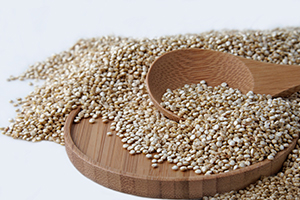
Despite its ancient roots, quinoa is still quite a mysterious food, with many people shying away from it because they don’t quite know what it is or how to pronounce it. We will take a closer look into quinoa and demystify this superfood.
Pronounced “keen-wah”, this member of the goosefoot family is a pseudocereal and closely related to beetroots and spinach. The three most common kinds are red, black, and white. Quinoa is grown primarily for its edible seeds, which are processed to remove the bitter coating, then cooked like grains such as rice. The crop is tolerant of many harsh growing conditions, such as high altitude, dry soil, sun, and cold temperatures. Quinoa has its historical roots in the Andean region of Peru, Bolivia, Ecuador, Chile, and Colombia where it was domesticated 3000-4000 years ago. Incas referred to quinoa as the “mother of all grains” and treated it as sacred, but during the Spanish conquest of South America quinoa cultivation was suppressed to favor wheat cultivation.
Quinoa has been making a major comeback in recent years partly due to high protein and nutrient content and also due to its gluten free status. A quick look into its nutritional profile will make it easy to see why quinoa is considered a superfood.
1 cup of cooked quinoa provides:
- 222 calories, 4 grams fat, 39 grams carbohydrates, 8 grams protein, 5 grams fiber
- 58% RDA for Manganese
- 30% RDA for Magnesium
- 28% RDA for Phosphorus
- 19% RDA for Folate
- 18% RDA for Copper
- 15% RDA for Iron
- 13% RDA for Zinc
- Flavonoids including Quercetin and Kaempferol
Not only is quinoa comparatively high in protein, it is a good source of essential amino acids, including lysine and isoleucine, which many plant based foods are often deficient in, giving quinoa an edge over many traditional grains. The high protein and fiber content contribute to quinoa’s low glycemic index, meaning it does not cause a sharp rise in blood sugar after eating. All of these attributes are especially important for those who have had bariatric weight loss surgery, including lap band, gastric sleeve, and gastric bypass, where the overall amount of food consumed in a day is less than typical and all necessary nutrients must be obtained from a smaller volume of foods. And if that wasn’t enough to get you running to the store to buy quinoa for dinner, it is also high in antioxidants and flavonoids, which may have anti-free radical, anti-inflammatory, anti-viral, and anti-cancer benefits.
Many Americans are going “gluten-free” lately, though many experts can not explain why. Those diagnosed with celiac disease, wheat allergies, and “non-celiac gluten sensitivity” account for the part of the population who must avoid the wheat protein for medical reasons. However, the number of Americans avoiding gluten far outnumber those with the potentially dangerous medical conditions. Whatever the reason for avoiding gluten, quinoa offers a gluten free grain substitute. While quinoa itself is naturally gluten free as it is technically not a grain, some products mix quinoa with other flours that may not be gluten free. If you need to eat gluten free foods, inspect all the labels on quinoa products to check their gluten free status.
Quinoa is not only healthy, but can be prepared quickly. After rinsing, it can be boiled using methods similar to preparing rice, oatmeal, or barley. Once prepared, quinoa can be eaten by itself, mixed with vegetables or beans, incorporated into meatballs or meatloaf, added to soups or stews, stuffed into tomatoes or peppers, or even mixed with fruit and cinnamon for breakfast.
The above food highlight is offered by Dr. Shillingford, M.D., P.A., a board certified general surgeon specializing in bariatric weight loss surgeries, including adjustable lap band, gastric sleeve, and gastric bypass. Dr. Shillingford and his staff enjoy providing our patients with information on foods that can be incorporated into a healthy post surgical diet. Dr. Shillingford’s gastric sleeve, gastric band, and gastric bypass patients come from all over South Florida, including Boca Raton, Fort Lauderdale, Miami, Delray Beach, Port St. Lucie, and the Palm Beaches.

 Am I A Candidate
Am I A Candidate  BMI Calculator
BMI Calculator  Why Choose Us
Why Choose Us